In the realm of bird conservation, the protection of nests plays a vital role. Understanding the legal framework surrounding bird nests is essential to ensure compliance and promote the well-being of avian species.
Moving a bird’s nest is a delicate process that should be approached with caution and consideration. While it may become necessary in certain circumstances, such as for the safety of the birds or to accommodate human activities, it requires careful planning and adherence to ethical guidelines.
Here, noticing the species, timing, and suitable alternative nesting sites is essential. By prioritizing the well-being of the birds and following proper procedures, we can ensure a successful relocation that minimizes disturbance and promotes their long-term survival.
However, if you are not aware of all these facts, I can help. This article explores the legal implications, consequences, and alternative approaches related to moving and coexisting with bird nests, focusing on mourning doves.
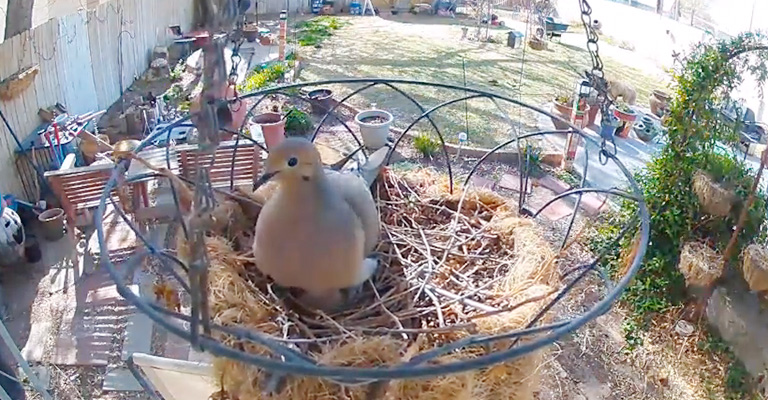
The Legal Protection of Bird Nests
In many countries, bird nests are legally protected to ensure the conservation and welfare of bird populations. Here are the facts you need to know.
Federal Laws Protecting Bird Nests
Bird nests are afforded legal protection under various federal laws in order to preserve and conserve avian species. These laws recognize the significance of nests as crucial components of birds’ reproductive cycles and habitats.
It is important to understand these legal protections to ensure compliance and promote the well-being of bird populations.
The Migratory Bird Treaty Act and Its Implications
The Migratory Bird Treaty Act (MBTA) is a key federal law that safeguards migratory birds and their nests. Enacted in 1918, the MBTA prohibits the removal, relocation, or disturbance of bird nests, eggs, and chicks without appropriate permits.
This act covers a wide range of bird species, including mourning doves, and is crucial in conserving their populations and habitats.
Specific Regulations Related
Under federal law, it is illegal to move an occupied bird nest without proper authorization. This means that if a mourning dove nest is currently occupied by adults or their offspring, it is protected, and interfering with it can lead to legal consequences.
These regulations aim to ensure the integrity of bird populations and maintain the natural processes of breeding and nesting.
By understanding the legal framework surrounding bird nests, including the Migratory Bird Treaty Act and specific regulations, individuals can make informed decisions regarding the handling of bird nests, including those of mourning doves.
Respecting these laws is essential for the conservation of bird species and promoting responsible interactions with wildlife.
Essential Facts to Know about Mourning Dove Nests
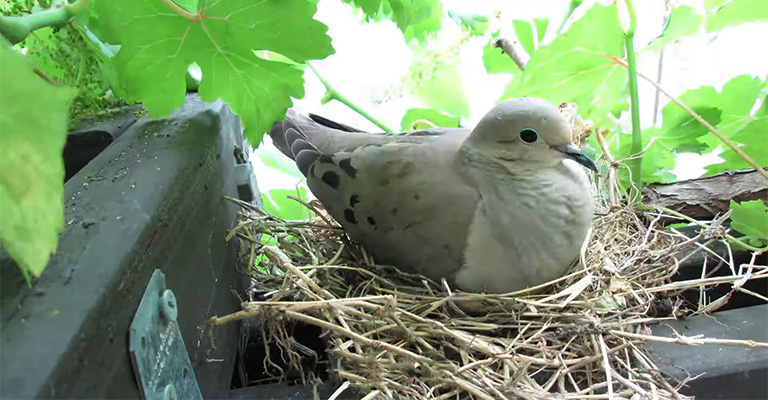
Before relocating a nest, you need to learn about some things related to a mourning dove nest. Here are some essential facts to know about mourning dove nests.
Mourning Dove Nests and Their Characteristics
Mourning doves, known for their soft cooing calls, construct relatively simple nests. Their nests are typically built using twigs, grass, and leaves, forming a loose, platform-like structure.
These nests are not elaborate and lack the intricacy seen in nests of some other bird species. Mourning dove nests are usually small, measuring around 6 to 8 inches in diameter.
Mourning Dove Nesting Behaviors
Mourning doves exhibit interesting nesting behaviors. They are monogamous birds, with pairs forming strong bonds during the breeding season. The male takes on the role of gathering materials for nest construction, while the female is responsible for nest building.
Both parents participate in incubating the eggs and caring for the hatchlings.
Nesting Preferences and Locations
Mourning doves have specific preferences when it comes to nesting sites. They often choose locations that provide protection and concealment. Common nesting sites include trees, shrubs, and sometimes even on the ground.
Mourning doves may also nest on ledges, beams, or other flat surfaces. They prefer locations that offer a clear view of the surrounding area, enabling them to monitor potential threats.
Understanding the characteristics of mourning dove nests, their nesting behaviors, and their preferred locations is valuable when considering interactions with these birds.
Respecting their nesting choices and providing suitable environments can help ensure the well-being of mourning doves and contribute to their successful breeding and survival.
Can You Move an Unoccupied Mourning Dove Nest?
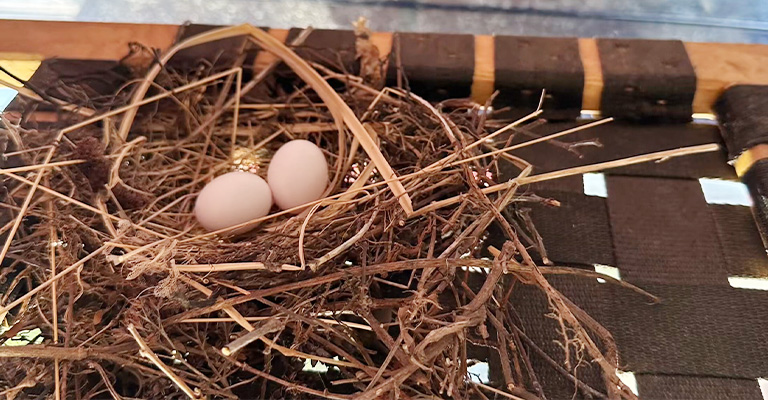
Yes, if an unoccupied mourning dove nest needs to be moved for a valid reason, such as for safety or to accommodate human activities, it is generally possible to do so.
Unlike nests with eggs or nestlings, unoccupied nests do not pose the same level of disruption or harm to the birds.
When moving an unoccupied mourning dove nest, it is important to remember the following factors.
Clarification on the Legality
When a mourning dove nest is unoccupied and still under construction, it is generally legal to remove it. Since federal laws protect occupied nests, the legality of moving an unoccupied nest depends on the specific circumstances.
It is essential to differentiate between active nests with eggs or chicks and nests that are empty or in the process of being built.
Precautions and Considerations
If you decide to move an unoccupied mourning dove nest, it is important to take precautions to minimize any potential harm. Use gentle and careful handling to avoid damaging the nest or its surroundings.
Make sure the new location is suitable and provides similar conditions to the original site, including safety, concealment, and protection from predators.
Be aware that any disturbance may discourage mourning doves from nesting in the area in the future.
Potential Benefits and Risks of Relocating a Mourning Dove Nest
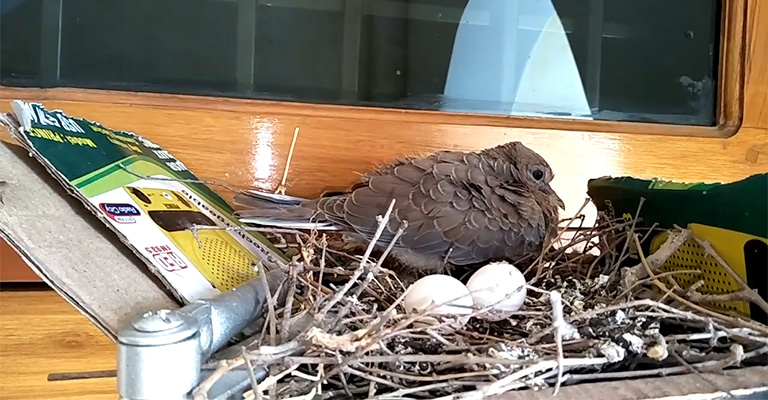
Here are some potential benefits and risks associated with relocating an unoccupied mourning dove nest:
Benefits
Safety From Disturbances or Hazards
By moving the nest, you can ensure the safety of the eggs or nestlings from potential disturbances or hazards in the original location. This could include human activity, predators, inclement weather, or other environmental factors that may pose a threat to the nesting birds.
Closer Observation
Relocating the nest can provide an opportunity to observe the nesting process more closely. This can be particularly valuable for educational or scientific purposes, allowing for detailed monitoring of the birds’ behaviors, incubation, hatching, and fledging.
Risks
Abandonment
One significant risk of moving an unoccupied mourning dove nest is the potential for abandonment.
Mourning doves are known to be sensitive to changes in their environment, and if they perceive the new location as unsuitable or unfamiliar, they may choose to abandon the nest altogether. This could result in the loss of the eggs or nestlings and disrupt their nesting cycle.
Disruption of Nesting Habits
Moving a nest can disrupt the mourning doves’ natural nesting habits. Mourning doves are creatures of habit and often return to the same nesting sites year after year.
By relocating the nest, you may discourage them from returning to the area and disrupt their natural breeding and nesting patterns.
Legal and Ethical Considerations
Before considering relocating a mourning dove nest, it is essential to consider the legal and ethical aspects.
In many countries, mourning doves are protected under wildlife conservation laws, and interfering with their nests or eggs without proper authorization may be illegal.
It is crucial to prioritize the well-being of the birds and their natural behaviors while respecting the legal protections in place.
Consequences of Moving a Mourning Dove Nest
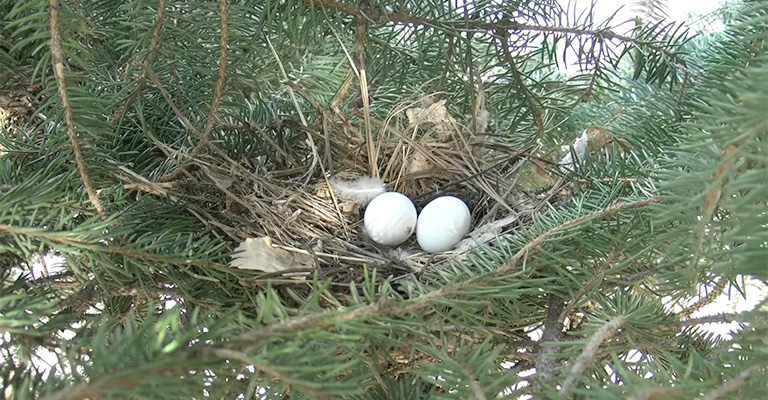
Now, you must be thinking about what can happen when you will move an occupied mourning dove nest, right? Here, I’ve listed the consequences of your concern.
The Legal Implications
Moving an occupied mourning dove nest is illegal under federal laws protecting bird nests. The Migratory Bird Treaty Act prohibits the disturbance, removal, or relocation of nests, eggs, or chicks without proper authorization.
Violating these laws can lead to legal consequences, including fines and penalties. It is important to understand and comply with these regulations to protect bird populations and their habitats.
The Mourning Dove’s Breeding Cycle
Moving an occupied mourning dove nest can have detrimental effects on its breeding cycle and population. Mourning doves rely on specific nesting sites for successful reproduction.
Disturbing or relocating a nest can cause stress to the birds, potentially leading to nest abandonment, disrupted incubation, or the loss of eggs or chicks.
Such disruptions can impact their ability to breed and raise offspring, negatively affecting their population dynamics.
The Importance of Respecting Wildlife
Respecting wildlife and allowing natural processes to occur is crucial for the conservation and well-being of species like mourning doves.
These birds have evolved to select suitable nesting sites and exhibit specific nesting behaviors that contribute to their survival.
Interfering with their nests disrupts these natural processes and can have long-term consequences.
Respecting wildlife means allowing them to carry out their reproductive behaviors without human intervention, safeguarding their populations, and maintaining ecological balance.
Understanding the potential consequences of moving an occupied mourning dove nest reinforces the importance of respecting legal protections and the natural behaviors of these birds.
It is essential to promote responsible interactions with wildlife, prioritize their well-being, and allow them to fulfill their ecological roles undisturbed.
When to Seek Professional Advice and Assistance?
We never suggest being overconfident and when it’s about a bird nest that is very much sensitive, we would like to suggest you seek help from a professional. Especially in the following cases, you need to do that.
Contact Local Wildlife Rescue Organizations
When faced with situations involving bird nests, it is advisable to reach out to local wildlife rescue organizations or relevant authorities. These organizations specialize in wildlife conservation and have the expertise to handle bird-related issues.
They can provide guidance based on specific regional laws and regulations, ensuring compliance and the well-being of the birds involved.
Their Expertise in Handling Bird-related Issues
Local wildlife rescue organizations and authorities have extensive knowledge and experience in handling bird-related issues.
They can assess the situation, determine the best course of action, and provide advice tailored to the specific circumstances.
Their expertise may include nest management techniques, providing alternative nesting sites, or addressing concerns related to bird behavior, all while prioritizing the welfare of the birds and adhering to legal requirements.
Contact Information and Resources for Seeking Assistance
To seek professional advice and assistance, you can utilize the following resources:
Local Wildlife Rescue Organizations
Research and identify reputable wildlife rescue organizations in your area. They often have hotlines or dedicated contact channels to report and seek guidance on wildlife-related concerns.
Wildlife Authorities or Departments
Contact local wildlife authorities or departments responsible for the conservation and management of wildlife. They can provide information on applicable laws and regulations and direct you to the appropriate channels for assistance.
Online Resources
Explore websites or online platforms of reputable wildlife organizations for information, guidance, and contact details of experts who can assist you.
Alternative Solutions and Coexistence
Of course, there are some alternative solutions that you can follow. Please check the below points.
Suggesting Alternative Approaches
Instead of removing or relocating bird nests, consider alternative approaches to address specific concerns.
For example, if a nest is causing inconvenience or safety hazards in a particular location, you can explore options such as implementing physical barriers or modifying the immediate environment to discourage nesting without directly interfering with the nest itself.
Consulting with experts can help identify effective and humane solutions.
Creating Bird-friendly Environments
To promote coexistence with birds, create bird-friendly environments that cater to their needs. This can include planting native vegetation, providing bird feeders or water sources, and creating suitable nesting opportunities.
Installing nesting boxes or platforms designed specifically for mourning doves or other bird species can offer alternative nesting sites, redirecting their nesting activities away from undesired locations.
Promoting Coexistence With Wildlife
It is possible to coexist with wildlife by striking a balance between human needs and the conservation of bird populations. This involves respecting legal protections, allowing natural behaviors to occur, and minimizing potential conflicts.
Educating others about the importance of wildlife conservation, responsible behavior around nesting birds, and the benefits of coexistence can foster a culture of respect and understanding.
By exploring alternative approaches, creating bird-friendly environments, and promoting coexistence, we can mitigate conflicts while ensuring the protection and well-being of birds.
It is essential to find sustainable solutions that enable us to appreciate and live alongside the beauty and importance of wildlife in our surroundings.
FAQs
Removing a mourning dove nest solely due to property damage is generally not recommended. It is important to explore alternative solutions such as installing barriers or modifying the immediate environment.
If the nest is causing significant structural damage or safety hazards, consult local wildlife authorities or experts for guidance on legal and humane options.
If you come across an abandoned mourning dove nest, it is best to leave it undisturbed. Mourning doves may reuse nests in subsequent breeding seasons, and interfering with the nest may discourage their return.
Allow natural processes to occur, and consider creating a bird-friendly environment to attract nesting pairs in the future.
Moving an occupied mourning dove nest is illegal under federal law. However, if you have concerns about the nest’s safety, consult local wildlife rescue organizations or authorities.
They can assess the situation and provide guidance on potential solutions or alternatives, ensuring both the safety of the birds and compliance with legal regulations.
Mourning doves can be sensitive to disturbances around their nests. If a nest is repeatedly disturbed or handled, there is a risk of abandonment. It is crucial to minimize disturbances and avoid unnecessary interactions to ensure the birds’ continued nesting and breeding success.
To attract mourning doves to your yard, create a suitable habitat. Plant native vegetation, provide a reliable source of water, and offer food, such as grains or seeds.
Consider installing nesting platforms or boxes specifically designed for mourning doves. Patience and providing a conducive environment can increase the chances of attracting nesting pairs.
Wrapping Up
When it comes to bird nests, understanding and respecting the legal protections in place is crucial. Moving occupied nests is illegal, while unoccupied nests require careful consideration and adherence to local regulations.
Creating bird-friendly environments and promoting coexistence can help mitigate conflicts, ensuring the protection and well-being of both birds and humans.
However, if you never move a bird nest before, we would suggest you ask for help from people who are good at it. Also, make sure not to harm the cheeks and the nest anyway.
Thank you for reading this blog and best of luck.